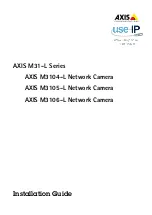
1 1 Gbit/s Ethernet I/O Module
111
E
SLB (Auto-Fallback Disable)
The SLB (Auto-Fallback Disable) type of team is identical to the Smart Load Balancing™ and
Failover type of team, with the exception of when the standby member is active, if a primary member
comes back on line, the team continues using the standby member, rather than switching back to the
primary member.
All primary interfaces in a team participate in load-balancing operations by sending and receiving a
portion of the total traffic. Standby interfaces take over in the event that all primary interfaces have
lost their links.
Failover teaming provides redundant adapter operation (fault tolerance) in the event that a network
connection fails. If the primary adapter in a team is disconnected because of failure of the adapter,
cable, or switch port, the secondary team member becomes active, redirecting both inbound and
outbound traffic originally assigned to the primary adapter. Sessions will be maintained, causing no
impact to the user.
Limitations of Smart Load Balancing™ and Failover/SLB (Auto-
Fallback Disable) Types of Teams
Smart Load Balancing™ (SLB) is a protocol-specific scheme. The state of support for IP, IPX, and
NetBEUI protocols is listed below.
The Smart Load Balancing™ type of team works with all Ethernet switches without having to
configure the switch ports to any special trunking mode. Only IP traffic is load-balanced in both
inbound and outbound directions. IPX traffic is load-balanced in the outbound direction only. Other
protocol packets are sent and received through one primary interface only. Failover for non-IP traffic
is supported only for network adapters. The Generic Trunking type of team requires the Ethernet
switch to support some form of port trunking mode (for example, Cisco's Gigabit EtherChannel or
other switch vendor's Link Aggregation mode). The Generic Trunking type of team is protocol-
independent, and all traffic should be load-balanced and fault-tolerant.
`
If you do not enable LiveLink
™
when configuring teams, disabling Spanning Tree Protocol
(STP) at the switch is recommended. This minimizes the downtime due to the spanning tree
loop determination when failing over. LiveLink mitigates such issues.
Operating System
Failover/
Fallback - All
Broadcom
Failover/
Fallback -
Multivendor
Load Balance -
All Broadcom
Load Balance -
Multivendor
Protocol
IP
IPX
Net
BE
UI
IP
IPX
Net
BE
UI
IP
IPX
Net
BE
UI
IP
IPX
Net
BE
UI
Windows Server 2003
Y
Y
N
Y
N
N
Y
Y
N
Y
N
N
Windows Server 2003
with SNP
Y
Y
N
Y
N
N
Y
Y
N
Y
N
N
Windows 2000 Server
Y
Y
Y
Y
N
N
Y
Y
N
Y
N
N
Y = supported, N = not supported












































